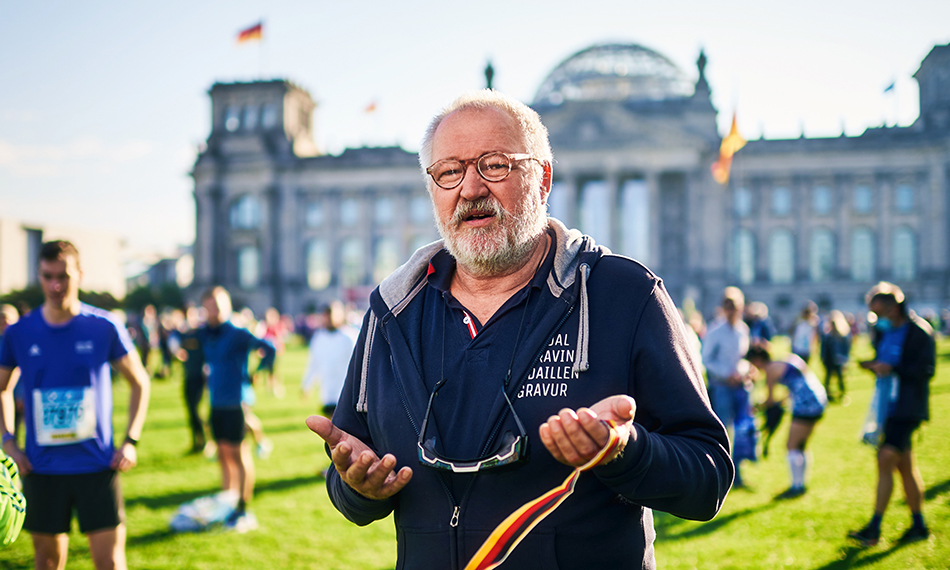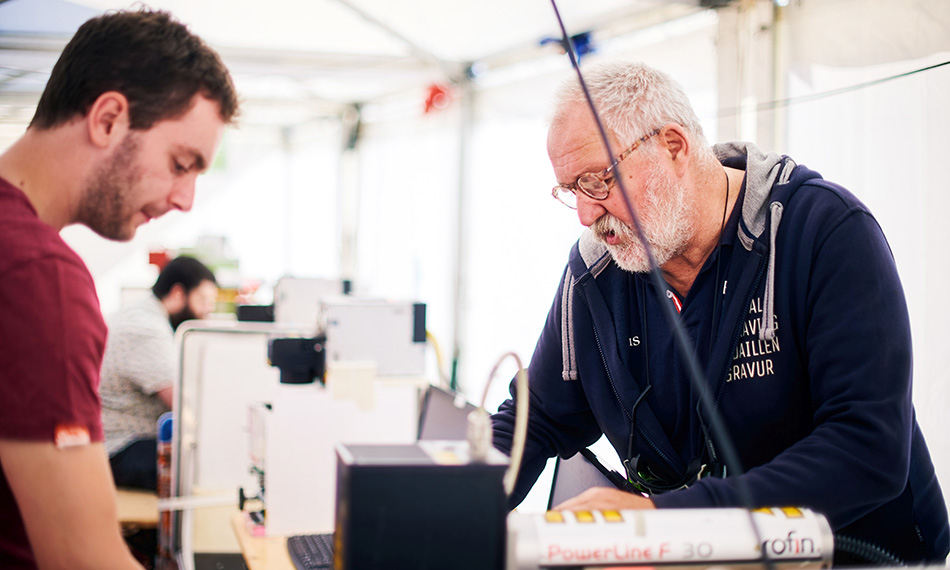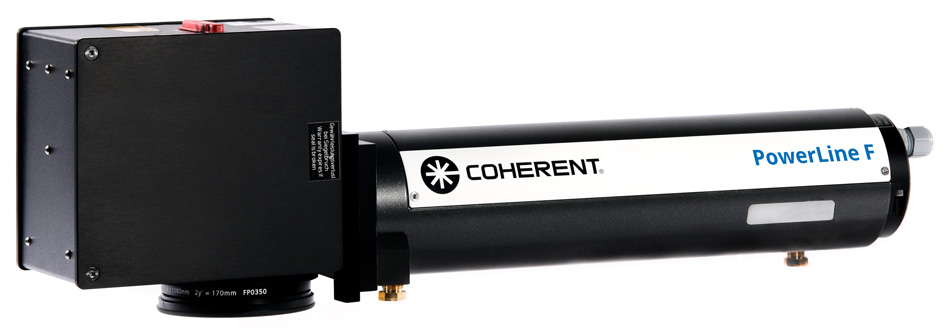CUSTOMER SUCCESS STORY
Laser Marker Gives Athletes a Personalized Medal
The Berlin Marathon 2021 has 25,000 participants, more than 4,000 of them will have their name and personal running time engraved on their medals immediately after finishing the marathon. Not far from the finish line, Klaus Huber and his team stand in a large tent and ensure that the medals are marked using a row of Coherent marking stations. One marking takes two seconds, so the team can process well over 1,000 medals per hour. Participants hand in their medal, walk to the other side of the tent and get their very own personal memento in hand. The marking is flawless, the process is well established. To get there it takes a good team, years of experience, and solid technology.
Good preparation counts
On Sunday at 8:30 a.m., not far from the Reichstag in Berlin, Klaus Huber stands in front of the long white tent with the eight marking stations. With his lederhosen (traditional leather trousers) he is easily recognizable as a true Bavarian. Klaus is calm and focused. He knows his customers well: "The athlete comes here with his personal medal; it must not be mixed up. And nobody wants to wait long after the marathon." So he has everything set up perfectly. Preparation always starts a month in advance: tent, tables, benches, power and data connection, everything has to be right. He lent the team for this from the local football champion’s Hertha BSC fan support. They have nerves of steel and the know-how to deal with athletes.
The final setup happens a day before the marathon. Eight markers are installed in the tent right next to the transport boxes. Most important is the data connection. The runners' data is transmitted in real-time from the timekeepers' computers and each marker station has access to it. All runners get a medal at the finish. Those who wish to get it marked show their number bib at the marking station and get their medal engraved.
A competitive swimmer all his life, Klaus Huber started marking medals two decades ago. At that time, there were already more than 6,500 medals to personalize. So he bought a marker from Rofin; at that time, marking devices were still heavy and included water cooling. Soon he also took over marathons, and today, Klaus Huber and his team take care of about 200 events all over Europe every year.
Over the years, he has regularly updated his machinery. And he has stuck with the brand, even though Rofin has since become Coherent. Today, he uses air-cooled solid-state and fiber lasers from the PowerLine F and PowerLine Prime series. At the Berlin Marathon, 8 of these were in use.
The starting signal is given and everything is running
The runners start from 9:00 am in several groups. The winner will reach the finish line shortly after 11 am. This is when the work at the marking stations starts. Klaus welcomes the exhausted but happy runners in front of the tent and assigns them a free stand. There they hand in their medal; their number is registered and they slowly walk around the tent. On the other side, their name is called and they get their medal back. The name, number, and running time are now clearly written on the bare metal - a souvenir for the rest of their lives. "The athletes leave the yard happily; I am the last contact they have here" is how Klaus describes the farewell.
Klaus is completely calm about it. In his marking marathon, it's important to keep the people going at a steady pace and to find solutions quickly without panicking, even when problems arise. Like that time they got the call from Italy. Klaus' wife and a team are taking care of the run in Jesolo. There is a problem with the laser. Klaus hands the phone over to Simon, an IT expert he brought with him from Munich. After ten minutes, everything is cleared up - a browser update has blocked the software. "It's often very simple things," Klaus reflects. "With a new laser, we've also had it happen that the operator couldn't start the system. After a few minutes, we knew he had forgotten to turn the key switch." In the end, the marking station must be working. That's what matters.
Precise marking - under all circumstances
Marking medals is just one of many applications for Coherent markers. They are part of a modular system in which the beam source and scanner can be precisely adapted to the user's requirements with additional components such as a camera system.
Many systems are sold to the semiconductor industry, where a long service life is crucial. Or they go into the medical device industry. There, for example, insulin injection pens are marked with the laser. Similar to medals, the main requirement there is that the marking looks nice. With other products such as implants, for example, the requirements are more technical. High-quality materials such as titanium have to be processed. And, of course, no particles must come off the marking.
The requirements for the markers are usually special. Thanks to the modular system, all parameters can be optimized, so that even demanding users end up with a reliable system.
Good service is mandatory
Klaus Huber makes a series of application tests before every new purchase. He has obtained particularly difficult medal blanks for this purpose. The process parameters are varied until the quality of the marking is right. And, of course, the speed has to be right. "Only when everything is running smoothly do we buy," he says.
Innovation always interests him. The transition to air-cooled systems, for example, has not only made transport easier for him. Once, a water-cooled laser froze overnight and burst. The service employee was on site within a few hours and repaired the system. It is a big asset when you can rely on it.
After the competition is before the competition
It is getting late in Berlin. The last runners have also had their medals marked. They are just as happy as the first ones because they have reached their goal. They are finishers, they have completed the marathon.
The marathon is also coming to an end for Klaus Huber. 4,000 medals have been marked. If it wasn’t for the pandemic, this number would have been considerably higher. There were some special cases, but in the end, all were solved without much delay.
For Klaus, the end of the competition is like the pre-competition setup in reverse. The lasers are carefully packed back into the transport boxes. It’s a final step that’s done with care; the markers have to withstand all the bumps of transport. The next weekend, at the next competition, they are back at work again. Klaus calculates 30 minutes to unpack and set up each system. Then the laser must be running and ready to mark more medals.
Winning with Coherent laser marking
Marking is one of the most common applications of laser technology. With a tight budget, the equipment must work reliably and precisely - often under harsh conditions. Klaus Huber has been marking medals for 20 years. He uses several different systems from Coherent for this purpose, owning 19 devices in total. Speed, reliability, and flexibility are the reasons why he wins the contracts for marking medals at 200 events a year. And these are also the reasons why he uses Coherent markers for this purpose.
“For each laser, the process parameters are optimized in application trials prior to purchase. Coherent's expertise is crucial for success in this process.”
— Klaus Huber, MSM Huber.

Medal Marking Requirements
Robustness: The medal marking systems are set up in a new location every weekend. They have to function perfectly in different climates. Even just an interruption of one hour can cause considerable congestion for the runners and is therefore unacceptable.
Flexibility: Different materials are just as common as different geometries. In addition to robustness, the flexibility of the systems is therefore also crucial.
Speed: When marking several thousand medals in the shortest possible time, the speed of the system is of great importance. The process from acceptance to delivery of the medal must take less than 1 minute, and consists of 2-3 seconds for marking. In addition to the scanner speed, simple operator guidance through the software is also important.
Precision: For the athletes, the medal is a memory for life. The writing must not be smudged or blurred. It must be clearly and distinctly visible on various materials.
Cost: Both the purchase costs and operating costs are critical factors for markers. Despite the high requirements, the service life must be several years so that the investment pays off.

“I want to be finished when the starting gun goes off."

Figure 1: The runners arrive at the tent. They hand in their medal; the operator enters their bib number and slides the medal into the marker.

Figure 2: The Coherent PowerLine F series offers flexible laser markers that can be equipped with fiber lasers of 19 to 95 W power. They are designed for applications that require markings with excellent readability and high production throughput.